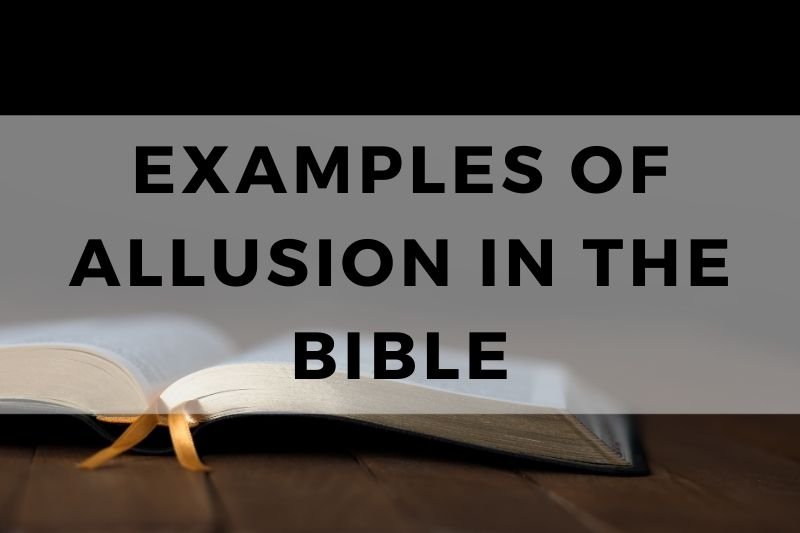
The Bible is full of allusions, references to other stories or ideas that enrich the text. These allusions help us understand the deeper meanings and connections within the Bible.
In this article, we will explore some examples of allusion in the Bible, shedding light on the interconnectedness of its stories and themes. Let’s dive into these examples to deepen our understanding of the biblical text.
10 Examples of Allusion in the Bible
#1. The Serpent in Genesis
In Genesis, the serpent tempting Eve alludes to Satan, the great deceiver, who continues to tempt humanity. This allusion sets the stage for the ongoing spiritual battle between good and evil. The serpent’s cunning and deceptive nature reflect the tactics of the devil in leading people astray from God’s truth. By recognizing this allusion, readers can understand the deeper spiritual implications of the story of Adam and Eve’s fall from grace.
#2. The Exodus
The Exodus story alludes to God’s deliverance of His people from slavery in Egypt. This event foreshadows the ultimate deliverance through Jesus Christ, freeing believers from the bondage of sin. The parallels between the Israelites’ physical liberation from Egypt and the spiritual freedom found in Christ highlight God’s faithfulness in delivering His people from oppression. By understanding this allusion, readers can appreciate the significance of God’s redemptive work throughout history.
#3. The Suffering Servant
Isaiah’s prophecy of the suffering servant alludes to Jesus Christ, who would suffer and die for the sins of humanity. This allusion highlights the sacrificial nature of Christ’s mission. The description of the servant’s suffering and ultimate victory over sin and death points to Jesus’ role as the Messiah who would bring salvation to the world. By recognizing this allusion, readers can grasp the depth of God’s love and the fulfillment of His plan for redemption through Christ.
#4. Jonah and the Whale
Jonah’s time in the belly of the whale alludes to Jesus’ death and resurrection. Just as Jonah emerged from the whale, Jesus emerged from the tomb, victorious over death. The parallel between Jonah’s three days in the belly of the whale and Jesus’ three days in the tomb underscores the theme of death and resurrection in the Bible. By understanding this allusion, readers can see the foreshadowing of Christ’s victory over sin and death for the salvation of humanity.
#5. The Passover Lamb
The Passover lamb sacrificed in Exodus alludes to Jesus as the ultimate sacrificial lamb, whose blood saves believers from spiritual death. The symbolism of the Passover lamb as a substitutionary sacrifice for the Israelites’ deliverance from judgment prefigures Jesus’ sacrificial death on the cross for the forgiveness of sins. By recognizing this allusion, readers can appreciate the connection between the Old Testament rituals and the fulfillment of God’s plan for salvation in Christ.
#6. The Bronze Serpent
The bronze serpent lifted up by Moses in the wilderness alludes to Jesus being lifted up on the cross for the healing and salvation of all who look to Him in faith. The image of the serpent on a pole as a means of healing for the Israelites bitten by snakes points to Jesus as the source of spiritual healing and salvation for all who believe in Him. By understanding this allusion, readers can see the connection between the Old Testament story and the redemptive work of Christ on the cross.
#7. Melchizedek
Melchizedek, a mysterious figure in Genesis, alludes to Jesus as a priest-king, foreshadowing Christ’s eternal priesthood and kingship. The description of Melchizedek as a priest of God Most High and king of Salem prefigures Jesus’ role as the ultimate high priest and king of kings. By recognizing this allusion, readers can understand the significance of Jesus’ dual role in mediating between God and humanity and ruling with justice and righteousness.
#8. The Day of the Lord
The concept of the Day of the Lord alludes to the final judgment and restoration, emphasizing the importance of living in readiness for Christ’s return. The imagery of the Day of the Lord as a time of reckoning and renewal underscores the need for believers to be prepared for the second coming of Christ. By understanding this allusion, readers can grasp the urgency of living faithfully and expectantly in light of the future fulfillment of God’s kingdom.
#9. The Tree of Life
The Tree of Life in Genesis alludes to eternal life in Christ, symbolizing the restoration of fellowship with God and the promise of immortality. The presence of the Tree of Life in the Garden of Eden represents God’s original intention for humanity to enjoy eternal communion with Him. By recognizing this allusion, readers can appreciate the hope of eternal life through faith in Christ and the restoration of God’s intended relationship with His people.
#10. The Covenant with Abraham
God’s covenant with Abraham alludes to the promise of salvation through faith, pointing forward to the fulfillment of that promise in Jesus Christ. The covenant God made with Abraham to bless all nations through his descendants anticipates the coming of Jesus as the ultimate fulfillment of that promise. By understanding this allusion, readers can see the continuity of God’s plan of redemption throughout history and the central role of Jesus in bringing salvation to all who believe.
Closing Thoughts
Allegory in the Bible serves as a powerful tool to convey deeper spiritual truths through symbolic stories and images. Through examples like the serpent in Genesis, the Exodus, and the suffering servant, readers can uncover profound messages about God’s plan for salvation and redemption.
These allegorical passages continue to captivate readers for centuries, inviting them to delve deeper into the rich tapestry of biblical narratives and uncover the hidden truths within.
